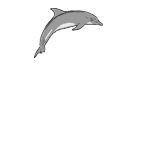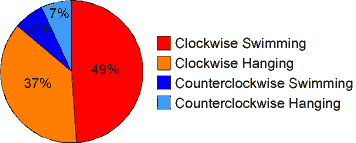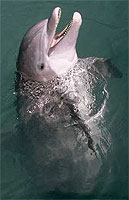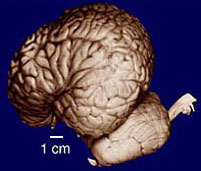 |
Swimming in Circles Clockwise direction preferred by Southern Hemisphere dolphins Counterclockwise direction preferred by Northern Hemisphere dolphins |
 |
 November 23, 2004
November 23, 2004Dr. Paul Manger at the University of Witwatersrand (Republic of South Africa) knew that dolphins in the Northern Hemisphere swim mostly in the counterclockwise direction. Researchers have suggested that dolphin brain anatomy, social behaviors or sleep patterns may be responsible for this counterclockwise preference. To investigate this topic further, Dr. Manger and Guinevere Stafne studied swimming behavior of dolphins in the Southern Hemisphere. Surprisingly, they found that these dolphins spent the majority of their time in clockwise behaviors.
The eight dolphins spent a total of 86% of their time in clockwise behaviors. Swimming in the clockwise direction took up 49% of the dolphins' time and hanging in the clockwise direction took up 37% of the time. The dolphins spent only 14% of their time in counterclockwise behaviors (swimming, 7%; hanging, 7%).

It is still unknown why Northern Hemisphere dolphins prefer
counterclockwise behaviors while Southern Hemisphere dolphins prefer
clockwise behaviors. Because the brains of dolphins are the same
regardless of where they live, it is unlikely that brain differences
account for the directional preferences. Stafne and Manger point out that
dolphins may be capable of sensing magnetic fields. Differences in the
Earth's magnetic fields in the Northern and Southern Hemispheres may cause
the dolphins to swim in different directions. Alternatively, the
scientists propose that differences in Northern and Southern ocean
currents may influence dolphin behavior. Future experiments may clear up this mystery. For example, what would happen if you transported a Southern Hemisphere dolphin to the Northern Hemisphere? Would this dolphin still continue to swim in the clockwise direction or would it switch to prefer counterclockwise directions? What is the behavior of dolphins in their natural environments? How does the size and shape of the swimming tank influence dolphin behavior? |
| Did you know?
|
|
Reference and further information:
|
| GO TO: | Neuroscience In The News | Explore the Nervous System | Table of Contents |
![[email]](./gif/menue.gif) Send E-mail |
 Fill out survey |
 Get Newsletter |
 Search Pages |
 Take Notes |
 Stafne and Manger studied four male and four female adult bottlenose
dolphins (Tursiops truncatus). These dolphins lived at the
Seaworld facility in Durban, South Africa. Each dolphin was observed for
four hours on four different nights. The researchers measured the time
each dolphin spent in four different behaviors:
Stafne and Manger studied four male and four female adult bottlenose
dolphins (Tursiops truncatus). These dolphins lived at the
Seaworld facility in Durban, South Africa. Each dolphin was observed for
four hours on four different nights. The researchers measured the time
each dolphin spent in four different behaviors:
